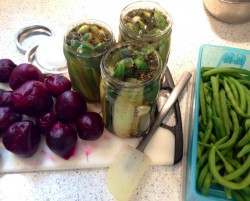 Eating locally and seasonally benefits everything from our physical health to our community’s economy. But, keeping up with the harvest’s bounty, especially in the midst of hot days and vacation season, can feel overwhelming. We’ve found the key to making eating with the seasons easy lies in the preparation — both preparing for the influx of fresh produce, and preparing veggies and fruits as soon as they come in the door. Read below for our top 4 tips for easy seasonal eating, and be sure to share with us any shortcuts you use to make eating local, fresh, and in season fun and easy!
Eating locally and seasonally benefits everything from our physical health to our community’s economy. But, keeping up with the harvest’s bounty, especially in the midst of hot days and vacation season, can feel overwhelming. We’ve found the key to making eating with the seasons easy lies in the preparation — both preparing for the influx of fresh produce, and preparing veggies and fruits as soon as they come in the door. Read below for our top 4 tips for easy seasonal eating, and be sure to share with us any shortcuts you use to make eating local, fresh, and in season fun and easy!
- Buy less at the store. This may seem like an obvious one, but most of us are creatures of habit who often pick up items from the produce section simply because it’s what we’re used to doing. Instead, look at what’s in season and what you’ll be purchasing locally for the week, and then consult your standard grocery list to see where you can substitute local foods the ones from the grocery store. We always buy Romaine lettuce and spinach from the store for salads, but when our farm has their red and green lettuces in season, we make the switch. When string beans are in season (like right now!), we use them in place of the asparagus we would normally buy at the store.
- Add veggies in. Rather than trying to come up with new recipes that use the vegetables you’re bringing in from your garden or the farmers’ market, think of where you can add them to your already-standard, go-to meals. For instance, add shredded or diced raw summer squash, beets, and radishes to your green salad. Chop up kale, Swiss chard, and collards and mix them in to egg, chicken, or tuna salad. In the fall, winter squashes and sweet potatoes are great additions to soups and stews.
- Prep produce. This includes the usual washing and rinsing, but also consider trimming up foods for snacking (e.g.: cut the green tops off strawberries, cut up celery and carrot sticks). Separate the greens from any root vegetables, as leaving the greens attached will pull moisture and other nutrients out of the bulb. You can save the greens or compost them. Blanch, roast, steam, or grill vegetables for easy snacking, quick sides, or adding to recipes. Blanch string beans to throw into stir-fries or dip in hummus. Roast beets to add to salads or serve as a side dish. Grill squash and eggplant for wraps and sandwiches. De-stem and chop greens so you can add a handful to your morning omelet or dinnertime quiche.
- Use easy preservation. Sometimes we’ll simply end up with just too much stuff! Save the summer’s bounty by using some easy preservation methods, such as freezing and pickling. Most vegetables can be cleaned, cut, blanched, and frozen, to then be enjoyed later in the year; click here for a guide to freezing vegetables. Certainly we all know that we can pickle cucumbers, but open up your mind to other possibilities: Carrots, string beans, asparagus, cauliflower — you name it, it can probably be pickled. Using a refrigerator pickle recipe makes the whole process super quick and easy.
>> In the photo: Roasted beets, refrigerator pickles, and blanched string beans waiting on the kitchen counter.
